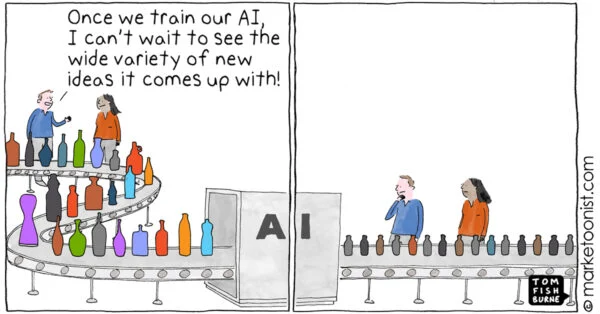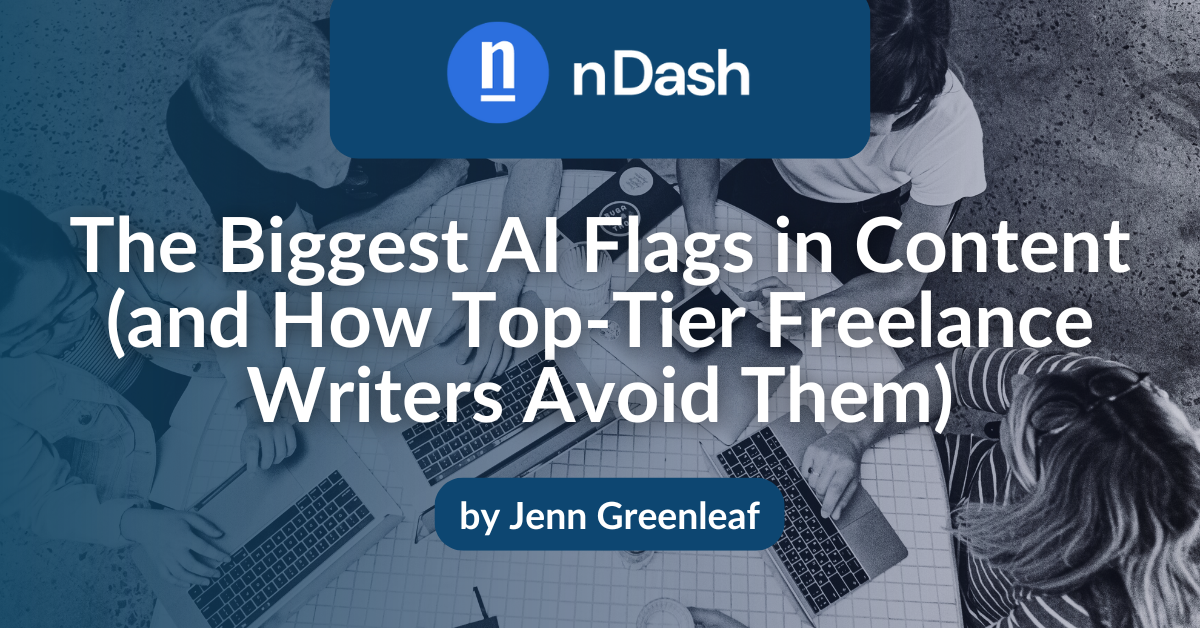At nDash, we connect brands with top-tier freelance writers who deliver expertise, perspective, and value no algorithm can replicate. Anyone can prompt AI. Only expert content creators know how to transform ideas into high-quality, brand-specific narratives that engage and convert. As our own 2025 content creation analysis shows, understanding what truly resonates with readers is essential.
We’re outlining the top AI flags in content and how to avoid them, based on honest marketer feedback and data.
TL;DR: What Are the Biggest AI Flags in Content?
- AI can boost efficiency, but over-reliance creates predictable, generic, and soulless content.
- Our 100-marketer survey revealed three clear AI “flags”: overly formal clichés, repetitive structure, and lack of human insight.
- More than half of the readers can identify AI content when compared side-by-side with human writing.
- Top-tier freelance writers avoid these pitfalls by using brand-specific language, varying pacing, and incorporating first-hand expertise.
- The winning formula: AI-assisted drafting, human-led judgment, fact-checking, and storytelling.
Why Do Brands Still Hire Top-Tier Freelance Writers in the Age of AI?
If AI could write it, why hire a freelance writer?
Anyone can run an AI prompt and tidy up a few sentences. Brands hire top-tier freelance writers for:
- Judgment: Knowing what serves the audience best.
- Creativity: Crafting original narratives and examples that AI can’t produce.
- Critical thinking: Structuring and refining ideas for maximum clarity and impact.
Despite AI’s prevalence, freelance writers remain essential because business leaders now expect content with an authentic tone and nuance. Generative AI often fails to replicate these qualities. Freelance writers also serve as strategic communicators who connect teams effectively. They help reinforce brand voice across complex organizational structures.
👉 More insights here: How Freelance Writers Act as Critical Problem Solvers in 2025 – nDash.com.
The Reality of AI Editing for Expert Content Creators
If AI drafts were ready to publish, my workload would have dropped, right? Unfortunately, that hasn’t been the case.
Over the past year, my work as an editor has actually increased, not decreased, because of AI. In some cases, I often:
- Rewrite 45-word sentences into concise, 20-word versions.
- Correct subtle factual inaccuracies.
- Reintroduce the human touch that AI output lacks.
Writer reminder: Even the best AI draft needs a skilled human editor to ensure accuracy, style, and voice.
The Accuracy Problem: Why Top-Tier Freelance Writers Still Matter
If AI says it’s accurate, do you trust it?
Too often, writers assume AI outputs are accurate. So, this past year, we ran an experiment to test AI’s fact-checking ability:
- We submitted three drafts to AI, asking it to flag inaccuracies.
- All came back marked “accurate.”
- Our project manager still found multiple incorrect statements.
Takeaway: Top-tier freelance writers verify every fact with credible sources instead of trusting AI’s confidence.
Here’s the thing:
When used well, AI can help you deliver even more value for the same budget. For example, a $500 assignment for 500 words of unique content could instead yield 1,500 AI-assisted words. You can then edit, fact-check, refine, and infuse those words with your expertise.
The result?
Content that’s more opinionated, more helpful, and more trustworthy.
To help you identify what not to do with AI, we asked over 100 marketers a simple question:
“As a reader, what words and/or phrases do you most commonly associate with AI-generated content?”
Within 72 hours, we had over 100 answers. The responses fell into three main “AI flag” categories:
- Overly formal and generic language.
- Stylistic and structural patterns.
- Lack of human qualities.
Their observations align with broader consumer trends. A survey shows that over half of readers can correctly identify AI-generated copy when compared side-by-side with human-written text. Now, with that in mind, let’s break down each flag category.

Image credit: AI-Generated Homogeneity cartoon – Marketoonist
AI Flag #1: Overly Formal and Generic Language
Ask yourself: If your first sentence could fit in a corporate brochure from 2005, is it really pulling readers in?
The biggest offenders were predictable openings and corporate clichés.
Top examples:
- “In today’s fast-paced world” / “In today’s digital age” (mentioned by 28% of respondents).
- “Cutting-edge…”
- “It’s important to note…”
- Overused buzzwords like leveraging, data-driven, and streamlined.
Additional examples:
- “Businesses must adapt or be left behind.”
- “At the end of the day…”
- “The fact of the matter is…”
How Top-Tier Freelance Writers Avoid Overly Formal and Generic Language
Top-tier freelance writers replace corporate clichés with language that is both precise and brand-specific. Instead of “In today’s fast-paced world,” they might open with a compelling stat or a question that challenges the reader’s assumptions. They could also begin with a vivid scenario from the client’s industry.
They lean on brand voice guidelines, industry research, and subject matter expertise to ensure every sentence sounds intentional and original. That strategy removes the AI “fingerprint” and builds a stronger emotional connection with the audience.
What is One Way Writers Can Ensure Their Language Feels Fresh and Original?
Anchor the writing in tangible, real-world specifics rather than abstract statements. Doing so instantly differentiates the content from formulaic phrasing.
Consider the following:
- Mention timeframes, locations, or statistics that ground the message.
- Use verbs that evoke action instead of passive or generic ones.
- Integrate audience-relevant cultural or industry references.
Writer reminder: If it sounds like it could have come from a press release or a high school debate paper, rethink it. Replace with precise, concrete language that reflects your unique perspective.
Tip: Swap clichés for sharp, brand-specific language. Lead with a surprising stat, a direct challenge to the reader, or a vivid industry snapshot.
👉 Additional resource:
Originality and audience insight keep content ahead of AI-generated work: Debunking Myths: 5 Content Marketing Fundamentals – nDash.com.
AI Flag #2: Stylistic and Structural Patterns
Does your content sound like it’s stuck in an “additionally” loop?
Marketers spotted patterns that AI often falls into:
- Repetitive sentence structures (e.g., multiple consecutive sentences starting with “This means…”).
- Unnecessary transitions (“Additionally…” every other sentence).
- Over-explaining obvious concepts.
Additional examples:
- Every paragraph ending with “In conclusion…”
- Reusing the same three-sentence structure repeatedly.
- Using three synonyms in a row for emphasis (innovative, groundbreaking, revolutionary).
How Top-Tier Freelance Writers Break Stylistic and Structural Patterns
Experienced writers vary sentence length, paragraph structure, and transitional language to keep readers engaged. They strategically insert short, punchy lines between longer, more detailed sentences. Instead of defaulting to “Additionally” or “Moreover,” they use transitions that match the brand’s tone and context.
Expert content creators eliminate filler by focusing on the most relevant information, ensuring each paragraph adds new value. The result is a dynamic reading experience that’s impossible to confuse with formulaic AI output.
How Can Writers Keep Their Sentence Flow Unpredictable and Engaging?
Think about pacing like a conversation, intentionally mixing rhythms and formats to keep the reader’s attention.
Ideas to try:
- Alternate between single-sentence paragraphs and multi-sentence blocks.
- Insert rhetorical questions to prompt reader reflection.
- Break complex points into short, standalone statements for emphasis.
Writer reminder: Vary sentence length, structure, and transitions to avoid a robotic reading experience.
Tip: Break the loop. Mix sentence lengths, vary paragraph shapes, and change transitions to keep the reader guessing.
AI Flag #3: Lack of Human Qualities
If your reader couldn’t tell you wrote it, why would they trust it?
The most telling sign of AI content? It lacks personality. Examples include:
- No first-hand experience or personal examples.
- Absence of strong opinions or nuanced takes.
- Generalizations with no supporting detail.
Additional examples:
- An article on productivity with zero mention of personal routines.
- A “review” of a tool that never references actual usage.
- Health advice without citing real patient or practitioner experiences.
How Top-Tier Freelance Writers Bring Back the Human Qualities AI Misses
Top-tier freelance writers infuse content with unique insights, first-hand experiences, and industry-specific anecdotes that AI simply can’t invent. They know when to insert a personal story, reference an off-the-record client insight, or share a behind-the-scenes detail to establish credibility.
Professional writers introduce subtle humor, cultural awareness, or regional nuance that resonates with the intended audience. These elements make the content memorable, persuasive, and distinct. They’re qualities that set human-crafted work apart from even the most advanced AI models.
How Can Writers Avoid the Most Common Signs of AI-Generated Content?
Writers can avoid the most common signs of AI-generated content by choosing language that feels intentional and context-specific. They should also incorporate subtle cues that convey lived experience and professional credibility.
Simple ways to put this into practice:
- Referencing recent, relevant industry events or trends.
- Using terminology and examples that align with the audience’s professional level.
- Incorporating sensory or environmental details to create immediacy.
Writer reminder: Infuse content with stories, opinions, and insights only you could provide. Generic openings and recycled language don’t just feel stale; they can signal to trained readers that the content is AI-generated.
Tip: Add the one thing AI can’t fake: your lived experience. Tell a quick story, share an opinion, or drop a detail only you could know.
👉 Additional resource:
We go into more detail about how AI is changing how readers engage with content in this post: Content Marketing in 2024 and Beyond: AI Marketing Strategies and Content’s Place in It – nDash.com.
Why Top-Tier Freelance Writers Will Always Outperform AI
AI can be a helpful tool, but it is no substitute for your expertise, judgment, and storytelling. Those who rely on it entirely will produce work that sounds like everyone else’s. Use it strategically to create work no one else could write.
Brands come to nDash for your ability to think, interpret, and connect, not for content anyone with a prompt could generate. Let AI support your craft, not replace it, and your work will stand out for all the right reasons.
